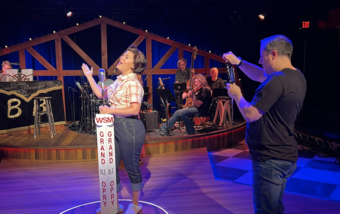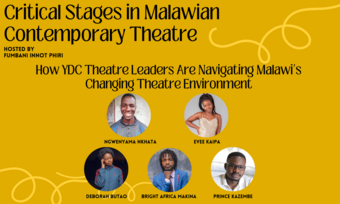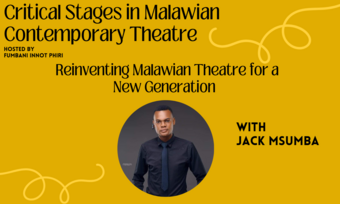Exploring Twittergate
Lessons Learned from Woolly’s Infamous Tweet Up Experiment
About a month ago, Woolly Mammoth came under fire for launching a new Twitter-based program aimed at deepening engagement with a new audience. There was a lot of support for the program, and a lot of fear as well. People loved it or hated it; quibbled with our language (this is not a tweet-up); wanted more access (it felt too top-down); wanted less access (the rehearsal room is sacred); shared strong opinions about live tweeting; and much more. We promised that we would allow the program to run its course, and then report back on what we learned. Below, you will find our reasons for embarking on such a project, our successes, and perhaps most importantly, our mistakes. It was early December when Woolly’s Director of Artistic Development, Miriam Weisfeld, approached Marketing and Connectivity about a new project she had just heard about: NASA’s TweetUp Program. There were many reasons for us to get really excited about this:
-
We’re Woolly. How could we not get excited about anything social media?
-
As a theatre with a strong Connectivity focus, we were excited to deeply engage a new group of individuals.
-
I was seduced by the idea of a community of ambassadors—millennials and others who were inspired to preach the sermon of Woolly.
-
We hoped we might reach non-traditional theatre audiences: people who might be intrigued by an experience like this, but who didn’t know much about theatre.
-
Miriam and Howard had been having a lot of conversations about greater transparency in the rehearsal room.
-
Innovation is the Woolliest of values. While this was not brand spankin’, it was a relatively new idea, and so we wanted to give it the old college try.
We met a few times to figure out how to do something like this ourselves. The plan: a call for applicants to join a “Tweet Up,” out of which we would pick three participants. The experimental nature of this undertaking led us to limit the number of participants. Our three participants were invited to attend our first rehearsal of Civilization (all you can eat), a technical rehearsal, and then the final dress rehearsal. Participants were invited to tweet their thoughts and reactions to these events using the show’s hashtag #WoollyCIV. The final dress rehearsal included the opportunity to tweet during the entirety of the performance. Now that all’s said and done, some of the best things to come out of the project are as follows:
-
The day it was announced we received a higher than average number of new followers on Twitter. Nine people entered the contest, but many more showed their support or opposition in the Twitterverse.
-
The three guests chosen were not Woolly subscribers, frequent attendees, or industry people. They had never seen our more challenging work; having purchased only for presentations or Fringe shows. They were intrigued to learn more about what we do.
-
The guests have since been frequent participators in the #WoollyCIV hashtag, sending out links to our articles as well as supporting show-related social media initiatives.
-
They were incredibly respectful of the process, and their live-tweeting was positive and enthusiastic. They were particularly excited to see the process realized, having witnessed this project from design presentations, through tech, and to its final form.
-
There were nine articles written about it in the press (including one in Forbes). Institutionally, we got press in the mainstream media about something other than our shows, and non-theatre people who don’t usually read about us started to pay attention. What better way to brand us than to have a story about us trying something new and stirring things up?
About a month ago, Woolly Mammoth came under fire for launching a new Twitter-based program aimed at deepening engagement with a new audience. There was a lot of support for the program, and a lot of fear as well.
We also made a lot of mistakes. We learned a lot and are hopefully smarter for it. Here are some lessons that might be helpful, should you want to try something like this too:
-
Make sure you discuss this idea with all the artists involved! This is where we made our first big mistake. We didn’t tell Jason that we were doing this, and he learned of it—like everyone else—on Twitter. Aah! It’s the most basic mistake, and as we’ve explained to Jason, it was indeed a mistake. We got caught up in the excitement of a new idea, and didn’t do our due diligence. I think Jason knows just how sorry we are. Don’t make the same mistake as us.
-
Use clear language. Our language around this endeavor seems to have been a little confusing. We used the term “tweet-up,” while our actual project had none of the social elements associated with such a program. Three people do not a tweet-up make. As for the tweet seats component of this program, this was a distraction from our main goals, and while not a big part of our process, was the focus of our many critics. Greater clarity may have prevented some of the misinformation in the press that followed.
-
Prepare for a lot of feedback. Before Jason’s statement on this project, we were already seeing blogs write about it: some positive, some weary. But then, when Jason got involved, the press went hog-wild. Articles in The Washington Post and Forbes.com were particularly attention-grabbing and a few donors and board wrote in with their concern. It is important to note that most of their frustration was with the “tweet seats” element of the program. I was extremely grateful for the support of Woolly’s leadership. They were excited to stir the pot and were behind us every step of the way. It’s important to know that about your leadership before embarking on such an adventure.
-
Don’t shy away from it, or, find your allies. When the news hit, and we started getting feedback, we tried to respond to everyone. We wanted to listen and learn, but we also wanted time to see how the experiment went, before making any final comments. We promised to present a fuller analysis when the project had been completed. Unfortunately, as we lost control of the story (as tends to happen on social media), it looked to people like we were cutting ourselves off, when in fact, we just didn’t know where all the conversations were happening. And yet, we had an entire cadre of board, staff, artists, claque, and designers, who could have been advocates for us. Indeed many of them told us later that they wanted to support us in the Twitterverse but didn’t know what to say. It would have been fairly simple for us to email them and let them know about the project, our goals, and how we were responding to feedback.
-
Don’t be afraid to try again. We asked for feedback from our participants. In the end, a lot of people were right—three people is too small a group for a project like this. We’d like to announce earlier, get a bigger group, and rather than doing three separate events, have a whole day dedicated to them. They can sit in on rehearsal, they can talk to the playwright and director, they can get a backstage tour, and we can add more of the social component that any good tweet up dictates.
-
To Tweet Seat or Not To Tweet Seat. We were really happy with how the Tweet Seats component of final dress went. Our tweeters were highly engaged through the whole process, and thoroughly enjoyed sharing their thoughts about the play in real time. No one was looking to be a critic; simply share an experience. It allowed us to comment on and understand nuances that might have been missed in a post-show discussion, highlight key moments that made the show for us, and most importantly, formed a bond between all of us. We didn’t have to be sitting next to someone to find a kindred spirit, and the connection really enhanced the event. We often talk about the value of live theatre as being one where people, strangers, sit in a room and share an experience. Tweet Seats is simply a heightened version of that connection. It was powerful indeed. Bottom line: we would like to replicate this in the future. And the additional benefit of real time word-of-mouth does not hurt us either.
We had a great time doing this and learned a lot. We hope the adverse publicity does not scare you from trying the same. If you’d like to share your thoughts, please comment below. Have you tried something similar? What have you found? We’d love to learn more and try again soon. We look forward to hearing from you.













Comments
The article is just the start of the conversation—we want to know what you think about this subject, too! HowlRound is a space for knowledge-sharing, and we welcome spirited, thoughtful, and on-topic dialogue. Find our full comments policy here
Thank you, Deeksha and Woolly, for sharing this with us. This is a very generous model for how to report back on bold moves. I especially love the call to replicate and develop on what you guys started here. If I find an opportunity to engage with this idea in my own programming I will aim to be as transparent with the findings! Very much appreciated.